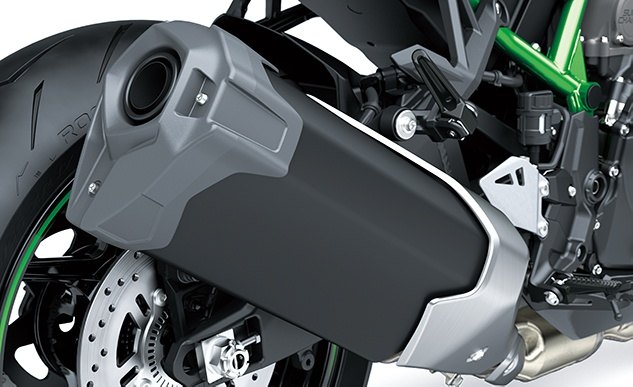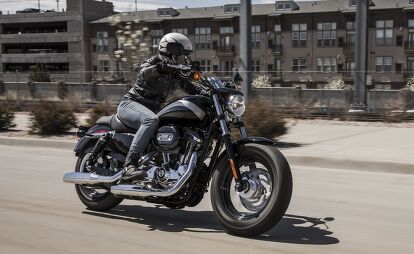What You Need to Know About Euro 5 Emission Standards for Motorcycles

EICMA is a week away, so motorcycle enthusiasts around the world are preparing for the deluge of new 2020 model announcements coming out of Milan.
Along with all the new bikes, you’ll probably hear a few mentions of “Euro 5” – a new emission standard that comes into effect on Jan. 1, 2020. As the name suggests, the new standard is being introduced for Europe, but because of how strict the standards are and how influential the European market is to the entire industry, Euro 5 will essentially be the de facto worldwide standard.
Let’s take a look at the Euro 5 standard and how it affects the motorcycles we’ll see in the near future.
What is Euro 5?
As you would guess, Euro 5 is the fifth set of European standards for motorcycles, aimed at reducing air pollutants produced by two-wheelers, as well as three-wheelers and even quadricycles. The standards are different for three- and four-wheelers, and also for motorcycles with smaller engine displacements, but for our purposes, we’re only going to focus on the regulations for larger, freeway legal models.
Euro 1 for motorcycles came into effect on June 17, 1999, followed by Euro 2 on April 1, 2004 and Euro 3 on Jan. 1, 2006. In 2013, the European Union revamped the entire system and laid out a roadmap for implementing Euro 4 and Euro 5.
Euro 4 came into effect on Jan. 1, 2017 for all brand new models, while existing models received an extra year to be updated to meet the changing standards.
That brings us to Euro 5, which applies to new models as of Jan. 1, 2020. As with Euro 4, manufacturers can bring back existing models for another year, but they will all need to conform to Euro 5 by Jan. 1, 2021.
How does Euro 4 differ from Euro 5?
Emissions standards are stricter across the board under Euro 5, with lower limits for carbon monoxide, unburnt hydrocarbons, and oxides of nitrogen (NOx).
Euro 5 also introduces a new standard measuring hydrocarbons excluding methane. Under the new rules, motorcycles must produce no more than 0.1 g/km of hydrocarbons, with non-methane hydrocarbons (NMHC) representing less than 68% of that amount. This may prove to be one of the bigger hurdles for manufacturers, as a significant amount of hydrocarbon emissions is not methane.
| Carbon Monoxide | Hydrocarbons | Non-Methane Hydrocarbons | NOx | Durability | |
| Euro 4 | 1.14 g/km | 0.170 g/km | N/A | 0.090 g/km | 20,000 km |
| Euro 5 | 1.00 g/km | 0.100 g/km | 0.068 g/km | 0.060 g/km | Vehicle Life |
Euro 5 also introduced a new standard for particulate matter emissions, but it only applies to diesel engines. Barring a sudden shift towards diesel, that doesn’t matter much for our purposes.
What does matter is a change to the durability of a bike’s emission control systems. Under Euro 4, vehicles must be certified to continue to meet emission standards after 20,000 km (about 12,427 miles) of mileage. For Euro 5, this has been extended to the estimated lifetime of the vehicle. This requires a new on-board diagnostic system beyond the one added in Euro 4.
Under Euro 4, motorcycles needed an OBD stage I system that monitors the electrical circuit and failures in the emission control system. Euro 5 mandated OBD stage II, which adds misfire detection and oxygen sensor deterioration. Euro 5 also proposed adding monitoring of catalytic convertors, but that has been pushed back to 2025.
Euro 4 also introduced a sound level limit of 80 dB for motorcycles with engines larger than 175cc. Euro 5 will establish a new cap on noise emissions, but the sound levels haven’t been determined yet and will be set in a separate piece of legislation.
Why do Euro 5 standards matter for the U.S. and other markets outside Europe?
Earlier, we referred to Euro 5 becoming a de facto worldwide standard, despite technically only being enforceable in the European market. Other countries, like the U.S., have their own national standards (plus California, which sets its own standards) which differ from the European standards. Carbon monoxide limits, for example, are much laxer in the U.S., at 12.0 g/km compared to 1.0 g/km under Euro 5.
| US Standards | Carbon Monoxide | Hydrocarbons | Hydrocarbons + NOx | Useful Life / Warranty |
| EPA 170-279cc | 12.0 g/km | 1.0g/km | N/A | 5 years/18,000 km |
| EPA 280+cc | 12.0 g/km | N/A | 0.8 g/km* | 5 years/30,000 km |
| CARB 50-279cc | 12.0 g/km | 1.0 g/km | N/A | N/A |
| CARB 280-699cc | 12.0 g/km | N/A | 1.4 g/km* | N/A |
| CARB 700+cc | 12.0 g/km | N/A | 0.8 g/km* | N/A |
| *Manufacturers may comply with HC+NOx as a corporate average | ||||
In theory, motorcycles being sold in the U.S. only have to meet the Environmental Protection Agency’s standards (or the California Air Resources Board for the Golden State). Some of the changes needed to become Euro 5 are so drastic, however, it’s more practical for manufacturers to change models for all markets than to produce multiple versions of the same model to meet different standards. By default, the most stringent standards holds the most influence in development.
Other markets have adjusted their own national standards to match Euro 5. India, for example, will be introducing its Bharat Stage VI (BS VI) standard on April 1, 2020, with emissions limits similar to Euro 5.
What are motorcycle manufacturers doing to meet Euro 5?
Manufacturers are employing many different strategies to meet the new emissions standards. Some of these steps were already put in place well before the Jan. 1, 2020 target date.
One idea is Variable Valve Timing or Variable Valve Lift. Several manufacturers have gone this route, with some notable recent examples including BMW’s ShiftCam (S1000RR and R1250 models), Ducati’s Desmodromic Valve Timing (Diavel and Multistrada 1260) and Suzuki’s VVT (GSX-R1000) already in production. We’re likely to see more in the years to come. Indian, for example, has applied for a patent that would give its Thunder Stroke engines VVT.
VVT lets manufacturers adjust valve overlap for different engine needs. In high performance engines, you typically want longer valve durations at high rpm, with lots of overlap with both intake and exhaust valves open at the same time. At low engine speeds, however, this leads to more unburnt fuel going out the exhaust valve, increasing the amount of hydrocarbons emitted. A VVT system counteracts this effect by reducing overlap at slower engine speeds while still providing more overlap at higher revs.
Another strategy we’re seeing is to increase engine displacement. There was a time when manufacturers introduced bigger engines to increase performance, but now we’re seeing them do it to reduce emissions. The Honda Africa Twin is one notable example, recently going from 998cc to 1,084cc. The BMW boxer models and the Ducati Multistrada also saw bumps in displacement alongside VVT.
With a bigger engine, motorcycles can produce as much or more power than a smaller engine at lower engine speeds, and thus, produce fewer emissions.
Will Euro 5 kill off some models?
While manufacturers will try to adapt most of their models to meet the new standards, inevitably some models will not be able to make the same transition, either because it would cost too much, or because the demand for those bikes isn’t high enough to be worth the effort.
We’re already seeing some models being discontinued, both in Europe but also here in North America. Air-cooled motorcycles in particular are becoming endangered with stricter emissions standards. This is especially noticeable in the disappearance of several cruisers from Yamaha and Honda. The Kawasaki KLR650, despite having a strong following, has also seen the axe.
Some models have continued on here in North America, despite being discontinued in Europe because of Euro 4. The Honda CBR600RR and Yamaha VMax live on in the U.S., which may indicate how popular they continue to be over here. The Honda Fury also continues to survive because… um… actually, we’re not sure why. Someone must be buying them, while the Honda Interstate and Stateline were last seen in 2016.
We’re expecting to see a lot of models at EICMA getting updates to meet Euro 5, but we should also see other bikes getting updated over the next year, thanks to the extra 12 months reprieve for returning models. Some models may return, but we’ll have to wait to see if they will continue past the Jan 1, 2021 deadline.

Dennis has been a part of the Motorcycle.com team since 2008, and through his tenure, has developed a firm grasp of industry trends, and a solid sense of what's to come. A bloodhound when it comes to tracking information on new motorcycles, if there's a new model on the horizon, you'll probably hear about it from him first.
More by Dennis Chung











































Comments
Join the conversation
I also see in the road tests that the euro 5 motorcycles seem to get worse fuel mileage than the same model did under euro 4. That seems a little counter productive.
.
Just follow the money, that all you need to know!